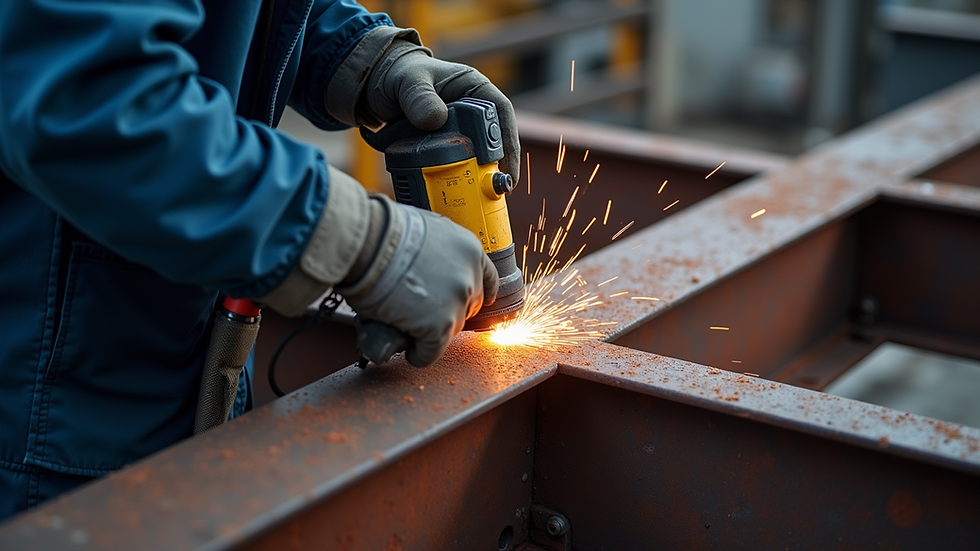Enhance Safety with Magnetic Particle Testing
- Thomas R. Hay, Ph.D., P.E
- Jul 30
- 4 min read
Ensuring the safety and integrity of critical components in industries such as aerospace, automotive, and construction is paramount. One of the most reliable methods to detect surface and near-surface defects in ferromagnetic materials is magnetic particle testing. This non-destructive testing technique helps identify flaws that could lead to catastrophic failures if left undetected. In this article, we will explore the fundamentals of magnetic particle testing techniques, their applications, and how they contribute to enhancing safety across various sectors.
Understanding Magnetic Particle Testing Techniques
Magnetic particle testing (MPT) is a non-destructive testing method used to detect surface and slightly subsurface discontinuities in ferromagnetic materials like iron, nickel, cobalt, and some of their alloys. The process involves magnetizing the component and then applying ferrous particles, either dry or suspended in a liquid, to the surface. These particles gather at areas where magnetic flux leakage occurs, typically at cracks or defects, making them visible under proper lighting conditions.
There are several magnetic particle testing techniques, including:
Wet Method: Uses a liquid suspension of magnetic particles applied to the magnetized surface. This method is highly sensitive and suitable for detecting fine cracks.
Dry Method: Employs dry magnetic particles sprinkled over the surface. It is convenient for field inspections but less sensitive than the wet method.
Continuous Method: The magnetic field is applied continuously while particles are being applied.
Residual Method: The component is magnetized, particles are applied, and then the magnetic field is removed. Defects remain visible due to residual magnetism.
Each technique has its advantages depending on the inspection environment, component size, and defect type. For example, the wet method is preferred in controlled environments for its sensitivity, while the dry method is often used in outdoor or field conditions for its ease of use.

Magnetic particles gather at defect sites on a metal surface during testing
Applications of Magnetic Particle Testing Techniques
Magnetic particle testing techniques are widely used in industries where safety and reliability are critical. Some common applications include:
Aerospace Industry: Inspecting aircraft components such as landing gear, engine parts, and structural elements to detect cracks or fatigue.
Automotive Industry: Checking engine blocks, crankshafts, and suspension parts for surface defects that could lead to failure.
Construction and Infrastructure: Evaluating steel beams, welds, and pipelines to ensure structural integrity.
Manufacturing: Quality control of castings, forgings, and machined parts before assembly or shipment.
The versatility of magnetic particle testing makes it an essential tool for preventive maintenance and quality assurance. It helps avoid costly repairs, downtime, and potential accidents by identifying defects early in the lifecycle of a component.

Inspector performing magnetic particle testing on a steel beam in a construction site
What kinds of defects will magnetic particle inspection detect?
Magnetic particle testing is particularly effective at detecting a variety of surface and near-surface defects, including:
Cracks: These can be fatigue cracks, stress cracks, or manufacturing cracks that compromise the component's strength.
Seams and Laps: Imperfections formed during the manufacturing process, such as rolled seams or laps in metal.
Porosity and Voids: Small cavities or holes that may weaken the material.
Inclusions: Foreign materials trapped inside the metal during casting or forging.
Weld Defects: Such as lack of fusion, incomplete penetration, or cracks in welds.
The sensitivity of magnetic particle testing allows inspectors to detect even very fine cracks that might not be visible to the naked eye. This early detection is crucial for preventing failures in critical applications.

Technician examining welds for defects using magnetic particle testing
How to Perform Magnetic Particle Testing Effectively
To maximize the effectiveness of magnetic particle testing, follow these practical steps:
Surface Preparation: Clean the surface thoroughly to remove dirt, oil, paint, or rust that could interfere with particle attraction.
Magnetization: Apply the magnetic field using appropriate equipment such as yokes, coils, or prods. Ensure the magnetic field is strong enough to reveal defects.
Application of Magnetic Particles: Use either dry or wet particles depending on the inspection environment and sensitivity requirements.
Inspection: Examine the surface under proper lighting conditions. Ultraviolet light is often used with fluorescent particles to enhance visibility.
Demagnetization: After inspection, demagnetize the component to prevent interference with its operation.
Documentation: Record findings with detailed notes and photographs for quality control and future reference.
Proper training and certification of inspectors are essential to ensure accurate interpretation of results. Additionally, following industry standards such as ASTM E1444 or ISO 9934 helps maintain consistency and reliability.
Benefits of Magnetic Particle Testing for Safety Enhancement
Magnetic particle testing offers several benefits that contribute to overall safety:
Early Defect Detection: Identifies flaws before they grow into critical failures.
Non-Destructive: Does not damage the component, allowing continued use after inspection.
Cost-Effective: Reduces repair costs and downtime by preventing unexpected breakdowns.
Versatile: Applicable to a wide range of ferromagnetic materials and component shapes.
Fast and Reliable: Provides immediate results, enabling quick decision-making.
By integrating magnetic particle testing into regular maintenance schedules, organizations can significantly reduce the risk of accidents and improve the lifespan of their equipment.
Magnetic particle testing techniques are a cornerstone of modern safety protocols in many industries. By understanding how to apply these methods effectively and recognizing the types of defects they reveal, businesses can protect their assets and personnel. For more detailed information on related non-destructive testing methods, consider exploring magnetic particle inspection resources to expand your knowledge and capabilities.







Comments